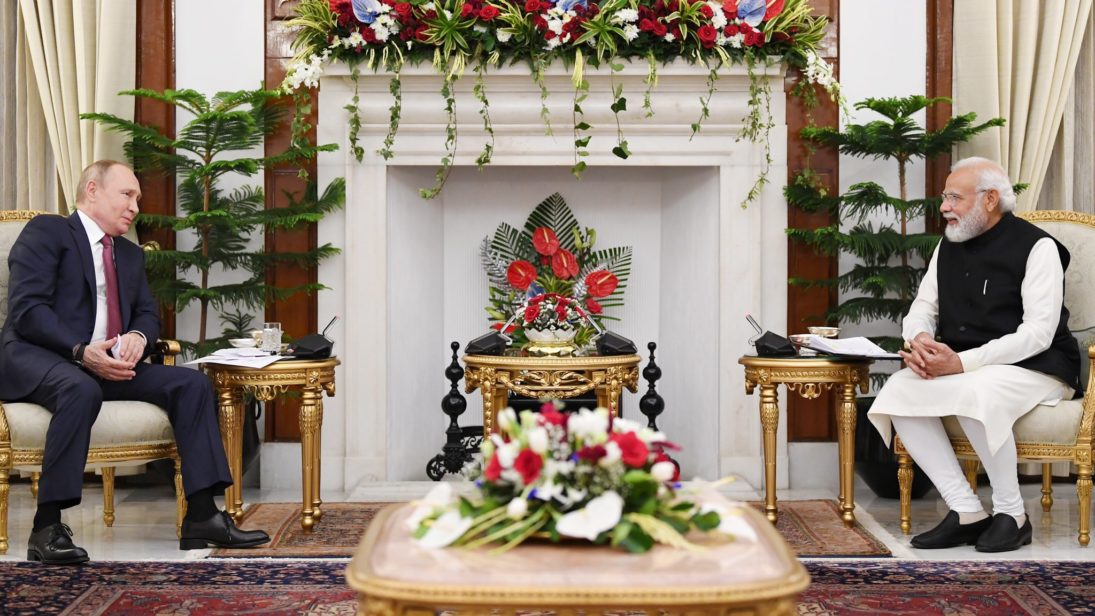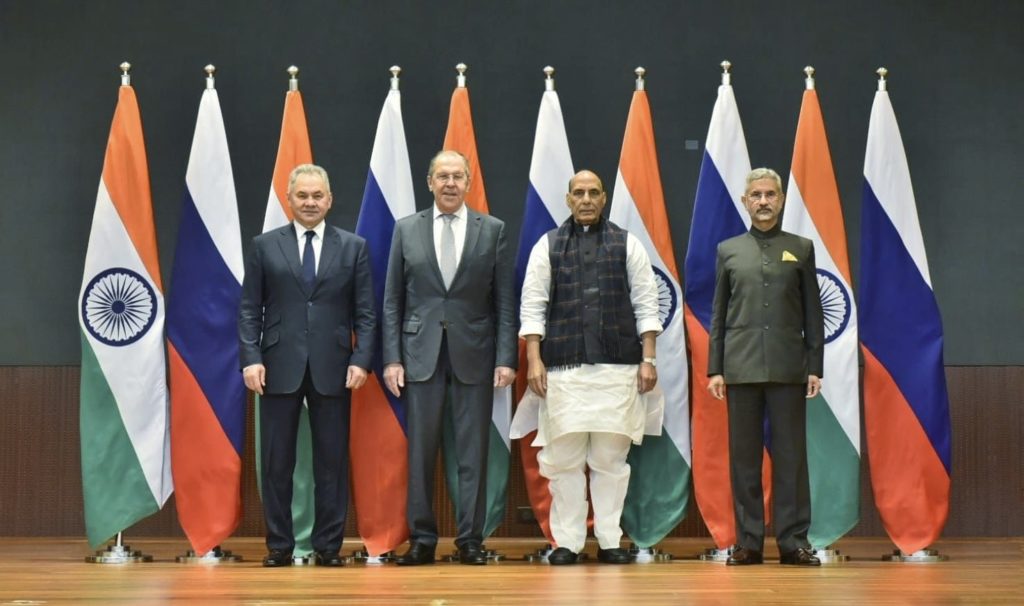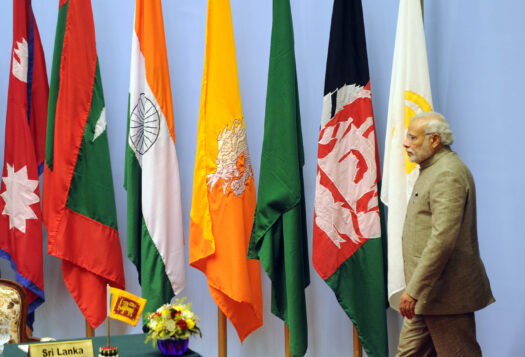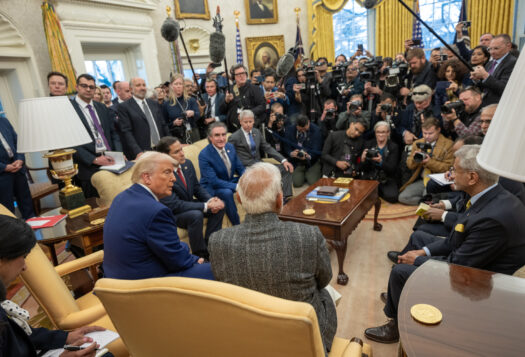
On December 6, 2021, India and Russia participated in their 21st annual bilateral summit. The decision from President Vladimir Putin to travel to India for the occasion speaks to the volumes of importance that Putin attaches to India-Russia strategic partnership. The summit sidelines also saw the first 2+2 talks between Minister of Defense Rajnath Singh with his Russian counterpart Sergey Shoygu and External Affairs Minister S Jaishankar with his Russian counterpart Sergey Lavrov, all of which elevate the bilateral relations between the two countries to higher levels.
Since the two countries signed the “Declaration on the India-Russia Strategic Partnership” in 2000, the annual summit has consistently garnered attention due to its previous notable outcomes that have furthered bilateral ties. In the past two decades of the summit meetings, India and Russia have undertaken multiple high-profile initiatives to strengthen cooperation. Examples include Russia’s pledge to construct 12 nuclear reactors in India during the 15th annual summit in 2014, the agreement between India and Russia to build four frigates in 2016, the USD $5 billion deal to purchase the S-400 Triumf air defense system from Russia during the 19th annual summit, and the signing of the Roadmap for Cooperation in Hydrocarbons for 2019-24 during the 20th annual summit. Putin has not held back in giving priority to events that convey political “signaling”; this summit marked only his second official visit to another country since the outbreak of COVID-19 in 2020—the first being to the Geneva summit where he met U.S. President Joe Biden.
While this year’s summit produced 28 agreements between India and Russia…Russia’s agreement with India to continue supplying S-400 anti-missile system units was the most visible.
While this year’s summit produced 28 agreements between India and Russia—ranging from science and technology cooperation to a cultural exchange program—Russia’s agreement with India to continue supplying S-400 anti-missile system units was the most visible. India’s pursuit to add the S-400 missile system to its arsenal may come at a cost amidst the threat of sanctions under the Countering America’s Adversaries Through Sanctions Act (CAATSA) for continuing defense transactions with Russia. Given growing Indo-US defense ties in recent years, CAATSA sanctions would impact India’s quest for a military modernization and its maritime interest in the Indian Ocean region. Given the time-tested partnership, India-Russia relations are beyond the clash of interest over Indo-Pacific concept, however India has taken note that Russia-China strategic maritime interests today have merged to include the Pacific, Indian, Mediterranean, Atlantic, and the Arctic, strengthening their naval partnership. India and the United States have inked multiple landmark agreements for deeper military cooperation and have been coordinating maritime strategy alongside Quad in the Indo-Pacific region. India needs a significant alliance with the United States to protect against China’s expanding partnerships in the region.
Contending with the withdrawal of the United States and the immediate takeover of the Taliban in Afghanistan topped the list of priority engagements for India and Russia at their summit. Both India and Russia are key extra-regional players that understand the domino effect a fragile Afghanistan can have on the neighboring countries. The two countries also carried forward the commitment to fight against terrorism at the summit made during the 13th BRICS summit held in September 2021 and during the high-level India-Russia inter-governmental consultations on Afghanistan led by the two national security advisers Ajit Doval and Nikolai Patrushev. India and Russia focused on counter-terrorism measures that would ensure that Afghanistan does not become a haven to terrorist outfits such as the Islamic State, al Qaeda, Lashkar-e-Taiba, and others.

Though the Afghanistan situation was given precedence in the summit and 2+2 talks, the “extended Troika,” composed of Pakistan, China, Russia, and the United States, convened to discuss Afghanistan right after the Delhi Conference without including India. Russia’s attendance at Pakistan’s conference reflects cautious optimism, not just in its role in bringing stability in the region but also in its cooperation with China and Pakistan. India might perceive that Russia sees China and Pakistan as more viable options than New Delhi’s to fill the security void in Afghanistan. India understands that Russia would like to see the former play an active role given its vested interests in the stability of Afghanistan to contain the rise of extremism and its foreign policy interests in Central Asia as an active member of Shanghai Cooperation Organization.
The 21st annual summit was an opportunity for both the countries to address factors that have been a cause of anxiety for India, especially China, which is still engaged in a prolonged military standoff at the Line of Actual Control. While Russia has maintained that the standoff is a bilateral issue between India and China, India sought Russia’s continued approach of neutrality on this aspect during the summit. Russia has kept this stance, however, one cannot ignore the growing defense partnership between Russia and China. Russia understands that diversification of defense procurement by India is a reality, and, hence, it has substantially increased its arms transfers to China, which has been one of the key factors in determining its position among arms exporting countries. Given these aspects, defense engagement today includes cooperation in sensitive fields, such as strategic missile defense, hypersonic technology, and the construction of nuclear submarines. An upgraded and well-equipped Chinese defense force with Russia’s assistance is a major concern for India’s security interests.
The annual bilateral summit is not just a diplomatic event, but a platform for the time-tested partners to discuss their interests and concerns that require critical introspection.
The annual summits, including this year’s 21st bilateral summit, have often produced feel-good rhetoric from both sides. However, one cannot overlook the underlying factors that have been a cause of concern in India-Russia relations. The annual bilateral summit is not just a diplomatic event, but a platform for the time-tested partners to discuss their interests and concerns that require critical introspection. Both India and Russia need to tread carefully, not just at the bilateral level but also manage their relationships with their bigger geopolitical allies—China and the United States—respectively. The partnership faces the main challenge of the growing proximity between India and the United States and Russia and China. The endurance of the strategic partnership between India and Russia will face inevitable challenges and largely depend on how the two countries safeguard their mutual interests, promote effective long-term goals, and create favorable conditions insulated from external factors.
***


